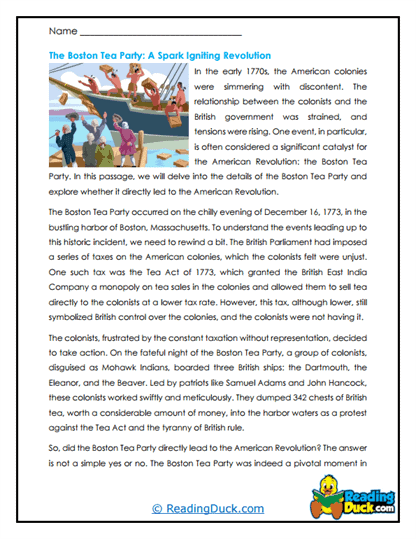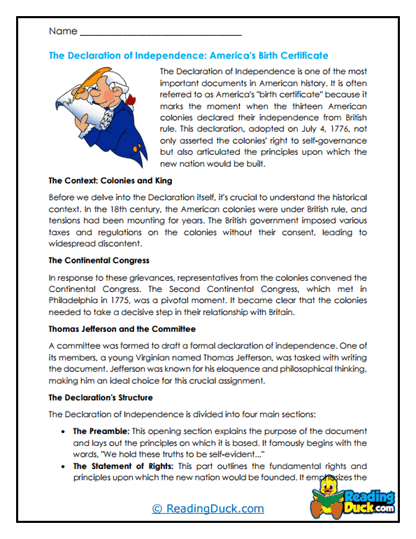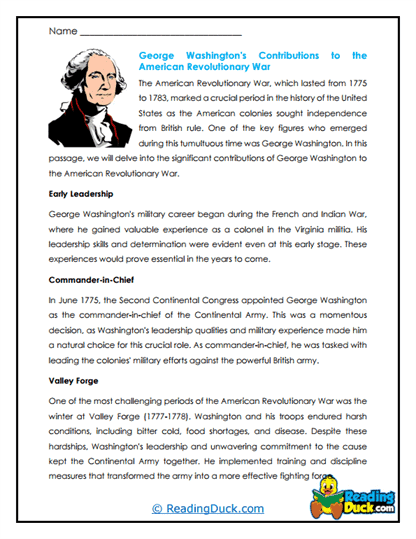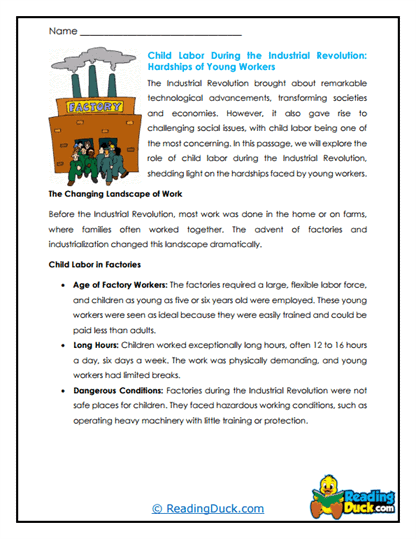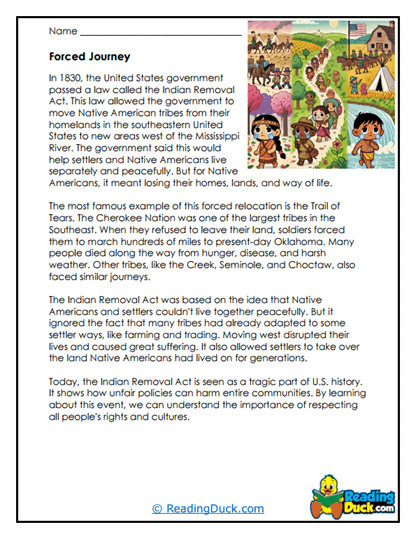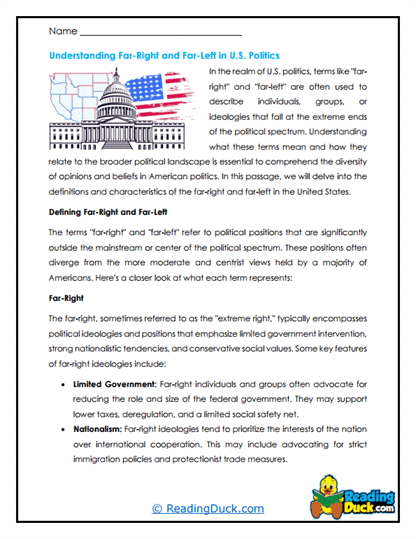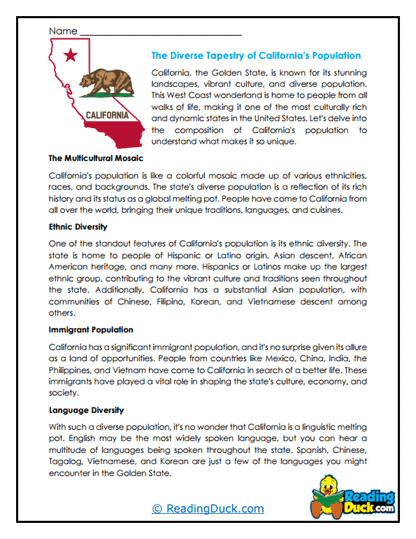U.S. History Worksheets
About Our U.S. History Worksheets
Our U.S. History worksheets are designed to engage students in the rich and complex story of the United States, from its founding to its development into a modern nation. Each topic in this collection contains multiple subtopics, focusing on different aspects of U.S. History. These subtopics are further divided into several worksheet sets that offer a comprehensive and interactive learning experience.
Each worksheet set includes:
- Multiple Choice Questions: These questions assess students' comprehension of the reading passage, reinforcing key historical facts and concepts.
- Short Answer Questions: These prompts encourage students to summarize and explain their understanding in their own words, fostering critical thinking and deeper engagement with the material.
- Open-Ended Questions: These questions invite students to express their personal views, opinions, and interpretations related to the historical events they’ve just read about, encouraging reflective and analytical thinking.
To support learning, each worksheet set comes with an answer key, and all worksheets are available as PDF files, making them easy to view, download, and print for use in both classroom and homeschool settings.
Understanding U.S. History: Key Events and Concepts
U.S. History is a vast and intricate tapestry that weaves together the stories of individuals, events, and movements that have shaped the nation. Understanding this history is crucial for students, as it provides context for the present and guidance for the future. By studying the major events and concepts that have defined the United States, students gain insight into how the country has evolved over time and how its foundational principles continue to influence its development.
Key Aspects of U.S. History Covered:
- Articles of Confederation: Explore the first constitution of the United States, which provided a framework for government but revealed the need for a stronger central authority, leading to the creation of the U.S. Constitution.
- Bill of Rights: Delve into the first ten amendments to the Constitution, which guarantee essential freedoms and rights to American citizens, forming the foundation of American democracy.
- Boston Tea Party: Learn about this iconic protest against British taxation, which became a pivotal event leading to the American Revolution and the fight for independence.
- Branches of Government: Understand the structure of the U.S. government, including the roles and responsibilities of the Executive, Legislative, and Judicial branches, and how they work together to maintain a system of checks and balances.
- Declaration of Independence: Examine the document that proclaimed the thirteen American colonies' independence from British rule, laying the groundwork for the birth of a new nation.
- George Washington: Study the life and leadership of the first President of the United States, who set many precedents for the office and helped shape the early republic.
- Great Depression: Explore the causes, impacts, and recovery efforts associated with the most severe economic downturn in U.S. history, which had lasting effects on American society and government policy.
- How a Bill Becomes a Law: Learn about the legislative process in the U.S. Congress, from the introduction of a bill to its potential passage into law, highlighting the complexities and importance of governance.
- Industrial Revolution: Discover how this period of rapid industrialization transformed the U.S. economy, society, and landscape, leading to significant technological advancements and urban growth.
- Political Parties: Trace the development of the major political parties in the United States, understanding their roles in the democratic process and how they reflect the diverse views of the American people.
- States of America: Explore the history and significance of each U.S. state, including their unique contributions to the nation's cultural and political landscape.
These topics provide a well-rounded exploration of U.S. History, allowing students to connect with the events and ideas that have shaped the country. By studying these key aspects, students gain a comprehensive understanding of the forces that have influenced the United States' past and continue to impact its future.
The Importance of Learning U.S. History: Building Informed Citizens
Studying U.S. History is essential for students of all ages, as it equips them with the knowledge and perspective necessary to participate fully in civic life. Understanding the historical context of the nation's development helps students appreciate the principles of democracy, the struggles for civil rights, and the ongoing efforts to build a more just and equitable society. This knowledge is crucial not only for academic success but also for personal growth and responsible citizenship.
By learning about U.S. History, students can better understand current events and the roots of contemporary issues. They can critically analyze how past decisions have shaped the present and how future actions can be informed by historical lessons. Moreover, studying U.S. History fosters a sense of identity and pride, as students explore the diverse stories that contribute to the nation's rich heritage. Whether aspiring to be future leaders, informed voters, or engaged community members, students benefit greatly from a solid grounding in U.S. History.
Practical Tips for Integrating U.S. History Worksheets Across the Curriculum
U.S. History is not just a subject for social studies classes; it can be integrated into various aspects of the curriculum to create a more interdisciplinary and enriching learning experience. Here are some tips for teachers and parents to incorporate these worksheets effectively:
- Cross-Curricular Connections: Link U.S. History topics with other subjects such as literature, art, and science. For example, students can study the literature of the American Revolution, explore art from the Industrial Revolution, or discuss the scientific advancements during the Space Race.
- Debates and Discussions: Encourage students to engage in debates or discussions on historical events, policies, or figures. This helps them develop critical thinking skills and understand multiple perspectives.
- Project-Based Learning: Assign projects that require students to research a historical event or figure and present their findings creatively. This could include creating timelines, designing posters, or producing short documentaries.
- Field Trips and Virtual Tours: Arrange field trips to historical sites or museums, or use virtual tours to explore significant locations in U.S. History. This provides students with a tangible connection to the past.
- Guest Speakers: Invite historians, veterans, or local government officials to speak to students about their experiences and insights related to U.S. History. Hearing firsthand accounts can make history more relatable and engaging.
- Role-Playing and Simulations: Use role-playing activities or simulations to help students understand historical events and decisions. For example, students can reenact debates from the Constitutional Convention or simulate the passage of a bill through Congress.
- Current Events: Connect historical topics to current events by discussing how past decisions and movements influence contemporary issues. This can help students see the relevance of history in their everyday lives.
- Creative Writing: Encourage students to write historical fiction, diary entries, or letters from the perspective of someone living during a particular period in U.S. History. This allows them to explore historical contexts creatively and empathetically.
- Group Work: Organize group activities where students collaborate on researching a historical topic and present their findings to the class. This promotes teamwork and communication skills.
- Technology Integration: Utilize online resources, digital archives, and interactive tools to enhance the learning experience. Students can explore primary sources, watch documentaries, or participate in online history games.
By implementing these strategies, teachers and parents can create a dynamic and engaging learning environment that helps students connect with U.S. History in meaningful ways. These worksheets serve as a valuable resource in fostering a deeper understanding of the nation's past, encouraging students to become informed and active participants in shaping its future.


